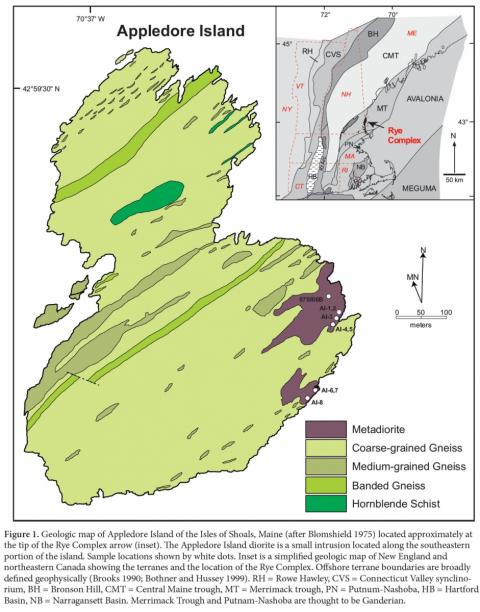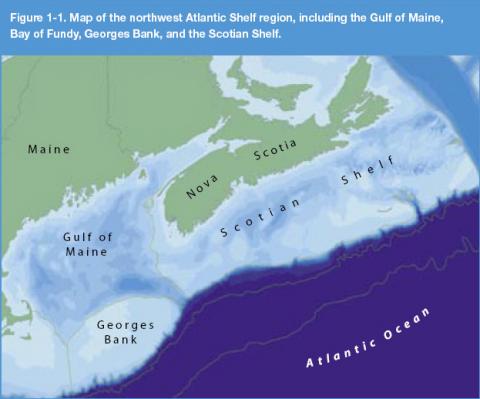A Short History of the Shoals Marine Laboratory
Shoals Marine Laboratory has a deep and rich history. We are proud of the fact that we were the first and remain the largest undergraduate-focused marine laboratory. With this focus, we serve a critical need of undergraduates to obtain field and research experiences that will serve them well in future educational and career endeavors. We are also very proud of our diverse faculty and student body, who come to our remote Maine island from around the world to create life-changing experiences and to make long-lasting scientific contributions.
| 1928 |
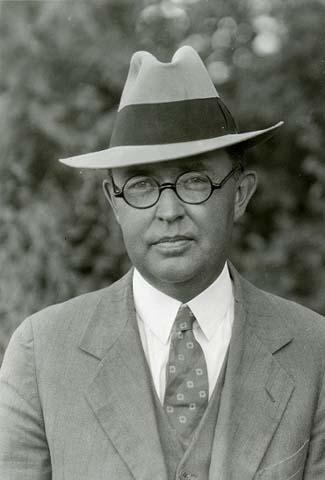
C. Floyd Jackson by Clement Moran 1930 |
| 1929 |
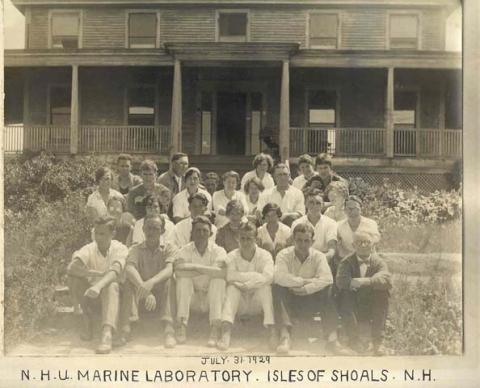
Marine Lab students in 1929 from Barnacle archive |
| 1966 |
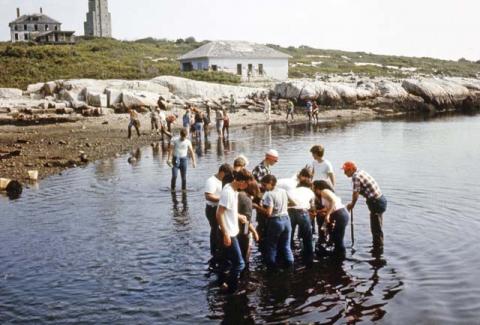
1969 Class field work. Photo: Steve Anderson Collection |
| 1970 | SML founding faculty included many Cornell faculty: John M. Kingsbury, John M. Anderson, John P. Barlow, Perry W. Gilbert, Oliver H. Hewitt, Edward C. Raney and Louise P. Bush from Drew University. |
| 1970s |
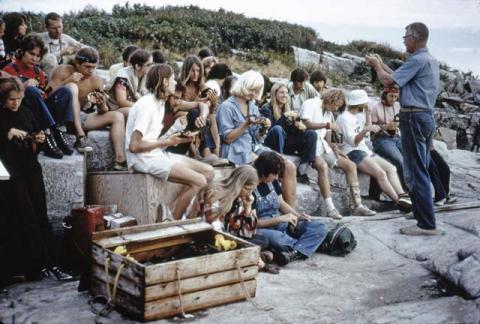
1973 Class Lecture. Photo: Steve Anderson Collection |
| 2000s | Focus on Sustainability: In 2007, an 80-ft wind turbine and rooftop solar panels became the first in a series of green energy projects on Appledore Island. SML's Sustainability Program Team installed a 26 kW solar panel array in 2014, followed by an additional 29 kW in 2015. Appledore's most recent "Green Grid" now supports 55 kW of solar energy - a major achievement! |
| Present |
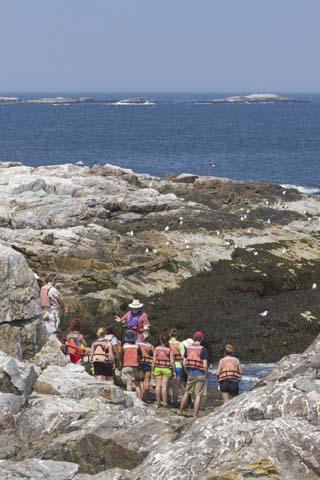
2014 Class field work. Photo: J. Coyer |
Human History
If you are interested in Appledore's human history, consider signing up for the Shoals History and Archaeology program for adults, hosted each summer in August. Spend four days, three nights at SML exploring the archaeological sites around Appledore, Smuttynose, and Star islands with faculty experts.
The Isles of Shoals Archipelago is composed of nine islands and numerous rocky ledges, six miles (10 km) off the New Hampshire/Maine border in the western portion of the Gulf of Maine. Appledore Island is located in Maine and is the largest (95 acres; 39 ha) and highest (65 ft.; 20 m) of the Isles. Formerly known as Hog Island, and prior to that as Farm Island; it is approximately 0.5 miles (0.8 km) from east-to-west and 0.6 miles (1.0 km) from north-to-south. The Isles of Shoals have played a larger role in American history than their size and numbers suggest.
Pre-history
The Isles were visited on a seasonal basis by Native Americans long before European contact. Pre-historic arrow and spear points have been discovered on several islands including Appledore and extensive excavations on Smuttynose Island have revealed stone tools, pottery shards, and flakes of stone; all of which imply hunting, food preparation, and food storage by the Native Americans during their extended seasonal visits. Smuttynose spear points have been dated to 6,000 years ago. Much of the details of Native American life on these islands is not yet clear, but archaeologists speculate that the islands were strategically located with a 360 degree view of the surrounding land and sea, as well providing abundant marine resources.
European Contact
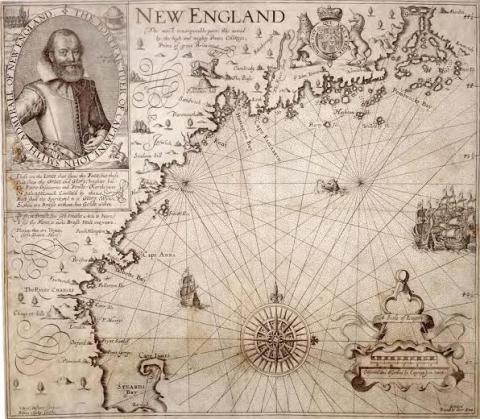
John Smith chart
European fisherman, like Basque sailors, were undoubtedly the first non-native visitors to the Isles of Shoals, but the first known written description was by Captain John Smith in 1614. The first recorded landfall of an Englishman was that of explorer Captain Christopher Levett, whose 300 fishermen in six ships discovered that the Isles of Shoals were largely abandoned in 1623. Levett described the Isles:
"The first place I set my foot upon in New England was the Isle of Shoals, being islands in the sea about two leagues from the main," Levett wrote later. "Upon these islands I neither could see one good timber-tree nor so much good ground as to make a garden. The place is found to be a good fishing-place for six ships, but more can not be well there, for want of convenient stage room, as this year's experience hath proved." - Drake 1875
At that time, the Isles were surrounded by dense concentrations of cod and this led to intensive seasonal fishing activities beginning in 1623. Early fishermen lived primarily on their vessels, but gradually began to construct dwellings on the islands. Year-round residents and livestock appeared from 1635-1640, with an estimated few hundred inhabitants on the islands by 1700. The first township, Appledore, included all of the Isles of Shoals, and was incorporated by the General Court of the Massachusetts Bay Colony in 1661. At that time, the province of New Hampshire and the province of Maine were both a part of Massachusetts Bay Colony. Due to heavy taxes in Massachusetts, there was a general migration of the population in the later 1600's to Star Island in New Hampshire. This lead to the establishment of the township of Gosport on NH's Star Island in 1715.

MidOcean House of Entertainment
By the early 1800s, human habitation and overgrazing by livestock reduced the native vegetation to isolated patches of low pasturage among mostly bare rock. Ruins of formerly prosperous fishing villages dotted the islands and only two islands remained inhabited (Star and Smuttynose). Sam Haley was one of the few people remaining on Smuttynose. His small store and tavern rapidly evolved into a successful village complete with a fishing operation, dock and warehouse, ropewalk, granary, distillery, brewery, The MidOcean House (burned in 1911), bakery, and several other businesses. The MidOcean House of Entertainment, which means it was a tavern, the entertainment being alcohol. Gambling, drinking, and smoking were popular activities among the fishermen when not working.
Reverend John Tucke, an Harvard educated minister moved to the Isles in 1732, he found a hard drinking, hard working population isolated from mainland laws, manners, mores and religion. He worked to civilize the fishermen community until his death in 1773. The American Revolution lead to big changes to this community. The Revolutionaries ordered the Shoalers to the mainland. Many dismantled their homes and brought them to the mainland. The few who remained, never recovered to their pre-revolution population nor activity levels. They were very isolated and poor, but the Isles came alive once again in the 1800's.
The Hotel Era
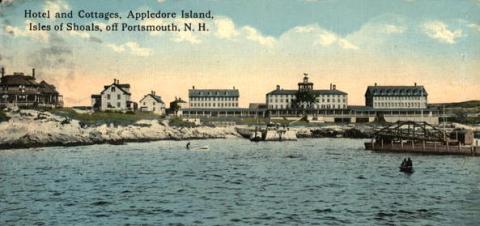
Appledore House Hotel postcard
Thomas Laighton had moved from Portsmouth to White Island in 1839, where he became the lighthouse keeper. Laighton, his wife Eliza, and three children (Oscar, Celia, Cedric). Light house keeping life was hard and isolated, the entire family moved to Smuttynose and took over running the Mid-Ocean House for Entertainment. Eliza became a renowned cook and the entire family enjoyed their new profession as Hoteliers. This gave Thomas a grand idea: The Appledore Hotel on Appledore Island. Opening in 1848, Laighton was ahead of his time when he envisioned Appledore as a successful island summer resort. Levi Thaxter, one of Thomas's business associates from a well connected Boston family, became a partner in the Appledore Hotel. Levi's Boston connections were vital and droves of Boston Brahmin came in droves to Appledore, the hotel was a huge success. After Thomas Laighton’s death in 1866, Oscar and Cedric ran the hotel and Celia served as hostess. Appledore House with up to 500 guests and the Oceanic Hotel (300 guests) on adjacent Star Island enjoyed wide spread reputations and prospered during the late 1800s.
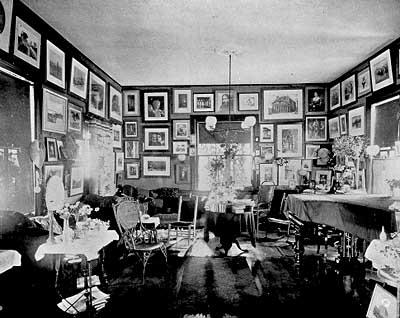
Celia Thaxter's Salon
Many guests and the certainly the famous artists were drawn to the island due to the popularity of Celia (Laighton) Thaxter. Celia, married at 16 to Levi Thaxter (27 years old), was a wife, mother, hotel hostee, and gifted poet. After their marriage in 1851, Levi and Celia Thaxter moved to Massachusetts. As a result of her poem Land-locked published in the Atlantic Monthly in 1860, she embarked on her literary career and became one of the country’s most popular poets. Celia’s unhappiness with life on the mainland and with Levi precipitated Celia’s solo return to Appledore in 1880. Her literary fame, combined with the ‘unsurpassed deliciousness’ of the Appledore oceanic air, the fine Hotel and her salon as a gathering place lead the to the development of one of America's first artist colonies. Among the many distinguished guests were: Nathaniel Hawthorne, John Greenleaf Whittier, Harriet Beecher Stowe, William Morris Hunt, Childe Hassam, Ole Bull, and NH-born President Franklin Pierce.
One of Celia most famous literary works was her book, An Island Garden. The book, written in the last years of her life, drew from Celia’s life-long love of nature; this love was evident in the garden she established in front of her cottage. Celia drew inspiration from the garden for her poems, prose, and art; indeed, the garden inspired also the American Impressionist Childe Hassam, who immortalized the garden’s vibrant colors and wildness in several world-renowned paintings. Celia died in 1894 and her home and garden were destroyed when the Appledore Hotel burned in 1914. In 1977, the garden was faithfully restored by John Kingsbury, first Director of the Shoals Marine Laboratory, following the detailed instructions in An Island Garden. The garden now is an important link to the Hotel Era of Appledore Island and is a popular destination for summer visitors from around the world.
Post WWII and Founding of Shoals Marine Laboratory
In the early 1900s, the hotel fell on hard times and was purchased by a syndicate. In 1908, the island was subdivided into several hundred small plots and several were sold. In 1910, the US Coast Guard established a life-saving station on Appledore and built the Coast Guard House (now Bartels Hall). In 1914, the Appledore Hotel burned to the ground and by 1930, most of the island was purchased by the Star Island Corporation.
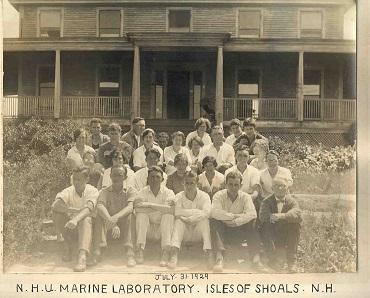
"The Barnacles" (July 31, 1929)
In 1928, Dr. C. Floyd Jackson of the Department of Zoology at the University of New Hampshire established the Marine Zoological Laboratory on Appledore utilizing buildings remaining from the Hotel Era and offered summer courses through 1940. During the war years, the island was occupied by military observers.
Appledore Island was abandoned following WWII and existing buildings were heavily vandalized over the subsequent years. After visiting the Star Island conference center in the early 1960s, Drs. John M. Kingsbury and John M. Anderson of Cornell University saw the Isles of Shoals as a better alternative to the Woods Hole Oceanographic Institution for undergraduate education. Consequently, they and a handful of other faculty brought Cornell undergraduates to Star Island in 1966 for a summer course in marine biology. The program was a big success and by 1973 the Shoals Marine Laboratory on Appledore had been established. From this single summer course and nine buildings, the Shoals Marine Lab currently offers 12-15 summer courses and consists of 16 buildings.
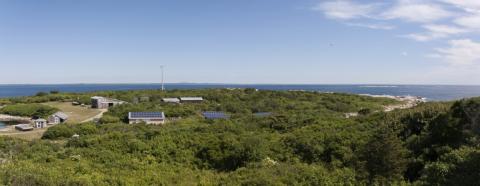
Solar panels and wind turbine are part of SML's Sustainabilty Program
In the last 10 years, the lab has embarked on an energetic sustainability program for conservation of water and generation of power. The entire SML community has participated in these efforts and helped us achieve an innovative green power grid (utilizing solar and wind energy), water conservation programs, a composting center, and more.
Location
The Isles of Shoals Archipelago is composed of nine islands and numerous rocky ledges, six miles (10 km) off the New Hampshire/Maine border in the western portion of the Gulf of Maine. Appledore Island is one of five islands located in Maine and is the largest (95 acres; 39 ha) and highest (65 ft.; 20 m) of all the Isles.
Geology
The Isles are the remnant base of an ancient mountain formed 300-400 million years ago that subsequently was eroded and most recently, scoured by ice sheets from the northwest during the Last Glacial Maximum (23,000 to 19,000 years ago). After the ice sheet receded, the Isles were connected to the mainland when the sea level was nearly 200 ft (60 m) below present levels, but gradual emergence of the Isles after the heavy ice receded and the sea level rose due to worldwide melting of glacial ice, led to separation from the mainland about 7000 years ago.
Botany
Vegetation colonized accumulated glacial til and the initial mosses and lichens, along with seabird nesting activities, began to form shallow layers of soil for subsequent colonization by more and larger species of plants. The maritime location of the Isles insures considerable deposition of salt spray, which profoundly affects virtually all island vegetation (e.g., growth, morphology, reproductive success). Appledore currently supports nearly 200 plant species (native and introduced), but the maritime exposure and shallow soil probably never supported many, if any, sizable trees. Several introduced plant species are present with the most common being purple loosestrife (Lythrum salicaria) and Japanese knotweed (Fallopia japonica). Fourteen distinct plant communities are present, ranging from salt marsh to moist shrub thickets with maritime shrub thicket and maritime meadow the dominant. The first botanical observations in the 1600's revealed a strong similarity to current patterns of vegetation cover and composition, undoubtedly because of the low level of human impact in both periods.
From the late 1600s through the hotel era in the early 1900s, however, human presence and activities drastically reduced both plant diversity and abundance. Subsequently, the intense human use of the Isles, in conjunction with sea bird nesting activities, probably explains the higher proportion of non-native vascular plant species on the Isles (42%) than in New Hampshire (27%) and Maine (30%).
No streams or running water exist on any of the islands, but fresh water ponds and springs are present on some and the largest of these are on Appledore. Two of the three fresh water ponds on Appledore (North, Central), occasionally dry out during a dry summer, whereas the third (Crystal Lake) rarely dries completely but can be significantly reduced.
Marine Environment
The Isles of Shoals lie within the Northern Coastal Shelf, one of several marine physioregions in the Gulf of Maine, and are characterized by a variety of habitat types and complex bathymetry, as well as high biological productivity. Numerous subtidal ledges (e.g., Jeffreys Ledge, Caches Ledge) and deep basins (e.g., Jeffreys Basin, Scantum Basin, Wilkinson Basin) are present, with substrata ranging from extensive bedrock to sand and gravel. The predominant surface current in the Gulf of Maine is broadly counter-clockwise, with water entering from the northern Scotian Shelf via the Northeast Channel and exiting via the Great South Channel just north of Cape Cod in the south. A smaller clock-wise circulation pattern is found around Georges Bank east of the Gulf of Maine.
Nearshore water temperatures at the Isles vary according to tides and protected/exposed coast (colder on exposed), but range from 35-70°F (2-21°C) during the year. However, the Gulf of Maine has warmed faster than 99.9% of the world’s oceans between 2004 and 2014.
Wildlife
Over 200 species of songbirds and waterfowl occur on Appledore as migrants, winter visitors, or vagrants from the mainland and since 1974, over 175,000 individual songbirds from 90 species have been banded. Since 1990, songbird banding has continued under auspices of the Appledore Island Migration Station, which is committed to the long-term study of nesting and migratory birds during spring and fall stopovers. The gray catbird is by far the most common of 12 songbird species regularly nesting on Appledore, followed by the common yellowthroat and song sparrow. Nesting waterfowl utilize the freshwater ponds and nearshore habitats of Appledore and include mallard and American black ducks, common eiders, Canada geese, and black guillemots. Essentially no common eiders were present before 1970, but over 200 nests were recorded in 2016. Snowy owls have started to overwinter on Appledore in the last four years.
Black-backed and herring gulls were severely depleted along the US east coast during the 1800s because of egging and shooting for feathers in the millinery trade (beginning in 1876). By 1900, black-backs were found only north of the Bay of Fundy and herring gulls only on the islands of eastern Maine (10,000 pairs). Herring gulls began to nest on Duck Island in the early 1920s and the first record of black-backeds breeding in the US was on Duck Island in 1928. During the 1940s, both species began nesting on Appledore and gradually increased after WWII after the island was abandoned by military personnel, open landfills and dumps appeared on the mainland, the Migratory Species Act (1914) was passed (which protected gulls), and lobster fishing increased (providing lobster bait and other waste). Herring gull numbers on Appledore have dropped considerably since 2003 probably because several mainland landfills have been closed and increased predation by black-backed gulls (primarily on chicks) and 13 raccoons (introduced and removed in 2004). The black-backed population, however, has remained relatively constant.
The Appledore Island Gull Banding project was initiated in 2004 with project leaders and students banding hundreds of adults and chicks of each species each year. The project monitors adult abundance, chick abundance and survivorship, and off-island re-sights. Most re-sights occur along NH and MA beaches, but Appledore gulls have been re-sighted in Florida and Texas. Gull populations now seem to have stabilized, with about 700 pairs of herring gulls and 500 pairs of great black-backed gulls nesting on Appledore each year from 2009-2016.

Great Black-backed Gull
Supported by the New Hampshire Fish and Game Department, the SML Tern Conservation Program implements research, restoration, and management of threatened and endangered terns on White and Seavey Islands in the Isles of Shoals. These islands are New Hampshire’s only successful breeding colony for Common (Sterna hirundo), Roseate (S. dougallii) and Arctic (S. paradisaea) terns, and are therefore a key conservation focus for the state.
Fluctuating populations of muskrats (commonly sighted) and Norway rats (rarely sighted) are present throughout the year. Genetic studies have revealed that the muskrat population probably was introduced in the early 1900s from the Rye (NH) area for the fur trade; rats undoubtedly were introduced when Europeans first settled in the area in the 1600s. An indeterminable number of bats migrate over and/or briefly stop on the island. The smooth green snake and northern brown snake were introduced in the 1930's. Red-backed salamanders and painted turtles were first observed in 1987 and 2005, respectively.
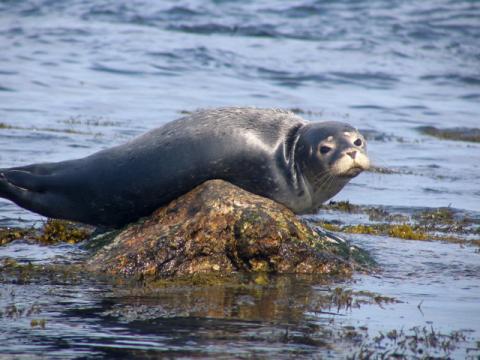
Harbor Seal
Hundreds of harbor (Phoca vitulina) and grey (Halichoerus grypus) seals haul out on Duck Island and adjacent ledges during the summer (some harbor seals also pup on the island in spring) and have been monitored photographically by SML research interns since 2011. In 2016, over 800 seals were observed at times, consisting of ca 600 and 200 harbor and grey seals, respectively. Adult seals of both species rarely, if ever, haul out on Appledore, although young harbor seals occasionally are observed in late summer.
The intertidal and shallow sub-tidal are inhabited by over 130 species of macro-algae and over 450 species of invertebrates; over 60 species of fish are found in nearshore waters. The overall species composition is essentially a subset of European and Icelandic marine communities, with a similarity to cold-water Canadian Maritime communities at depths greater than 60 ft (20 m). Introduced species of macro-algae and invertebrates are common on Appledore and in some cases, become a dominant component of the intertidal and/or sub-tidal assemblages. Dominance is highly variable and unpredictable, ranging from one year/season to decades. Tunicates (e.g. Botryloides violaceus, Didemnum vexillum, Diplosoma listerianum, Botryllus schlosseri), bryozoans (e.g., Membranipora membranacea, Tricellaria inopinata) and macroalgae (e.g., Codium fragile, Daysiphonia japonica, Colpomenia peregrina) are the main groups of introduced species. Other ecologically important introduced species include the periwinkle Littorina littorea (and two other species of Littorina), the green crab (Carcinus maenas), and Asian shore crab (Hemigrapsus sanguineus). Intertidal flora and fauna have been quantitatively monitored at five sites (exposed and sheltered) with replicated permanent vertical transects and photoplots by SML research interns since 2011. Intertidal temperature data have been collected continuously in exposed and sheltered locations since 2014.
The waters around the Isles of Shoals hold a great diversity of fish. The most common species in the shallow nearshore subtidal during summer months are the cunner (Tautogolabrus adspersus), pollock (Pollachius virens), winter flounder (Pseudopleuronectes americanus), rock gunnel (Pholis gunnellus), sculpins (Myoxocephalus spp), haddock (Melanogrammus aeglefinus), Acadian Redfish (Sebastes fasciatus), and spiny dogfish (Squalus acanthias). Atlantic Cod (Gadus morhua) are found in the area with breeding locations located in nearby Ipswich Bay and off shore. Atlantic bluefin tuna (Thunnus thynnus) are summer visitors to surrounding waters and Jefferys Ledge, located just off shore of Appledore island are known for productive fisheries.
Full Species lists are maintained for Shoals Marine Laboratory for flora and fauna.
Maps
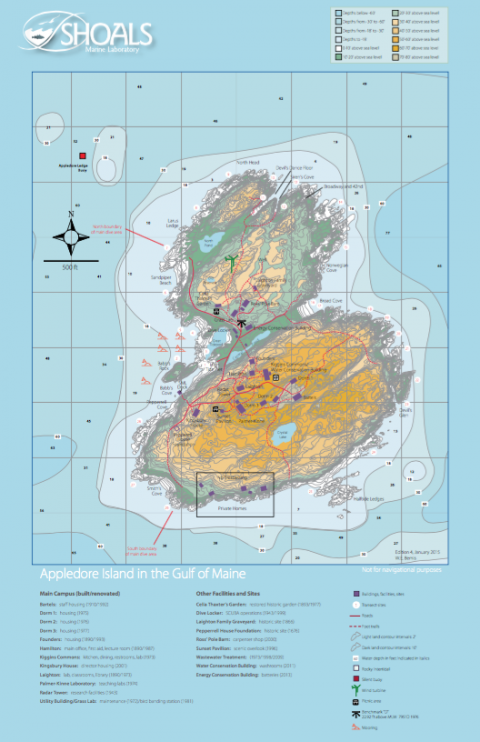
Map of Appledore Island 4th Edition (2015) by W.E. Bemis |
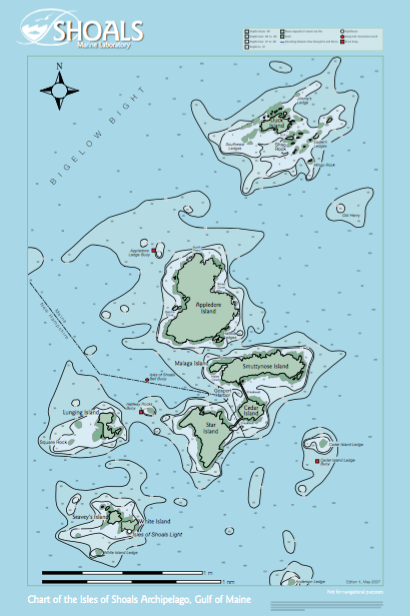
Isles of Shoals Map (not for navigation) by W.E. Bemis |
|
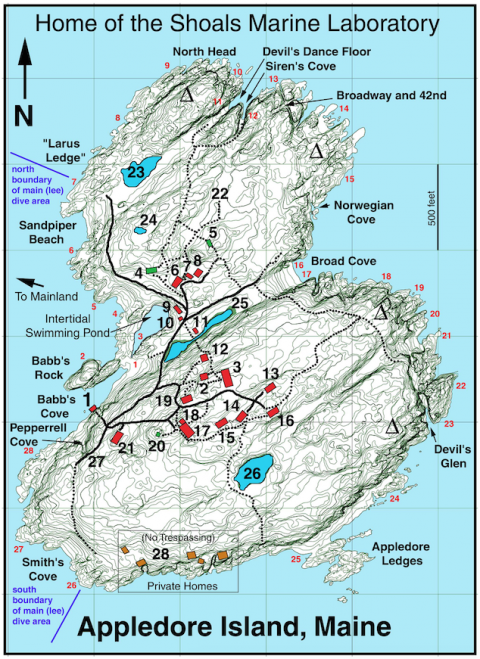
Appledore Research Sites Buildings, landmarks, features, dive sites, intertidal transects |
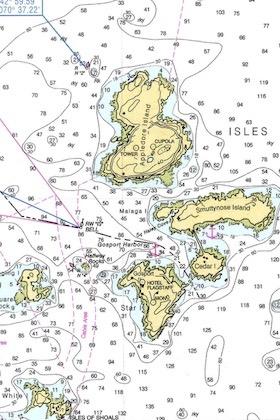
NOAA Chart #13283 Isles of Shoals |
|
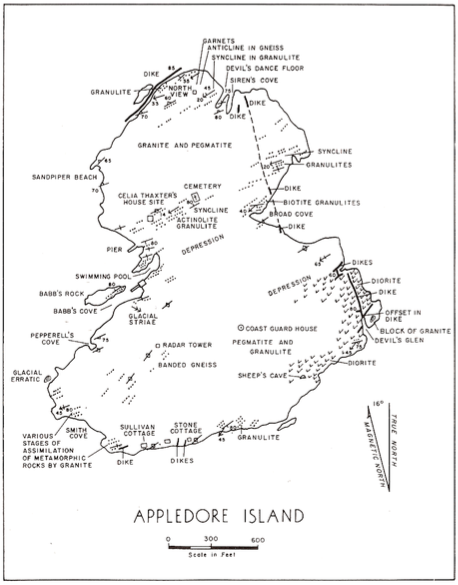
Appledore Island Geology |

